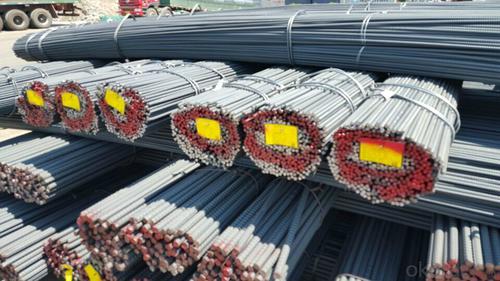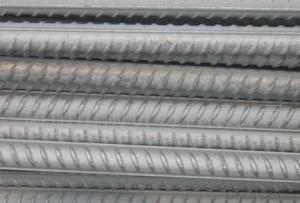Reinforcing Deformed Steel Bars in Grade HRB400
- Loading Port:
- Tianjin
- Payment Terms:
- TT OR LC
- Min Order Qty:
- 25 m.t.
- Supply Capability:
- 20000 m.t./month
OKorder Service Pledge
OKorder Financial Service
You Might Also Like
Specification
OKorder is offering high quality Hot Rolled Rebars at great prices with worldwide shipping. Our supplier is a world-class manufacturer of steel, with our products utilized the world over. OKorder annually supplies products to Africa, North American and Asian markets. We provide quotations within 24 hours of receiving an inquiry and guarantee competitive prices.
Product Applications:
Deformed bar is widely used in buildings, bridges, roads and other engineering construction. Big to highways, railways, bridges, culverts, tunnels, public facilities such as flood control, dam, small to housing construction, beam, column, wall and the foundation of the plate, deformed bar is an integral structure material. With the development of world economy and the vigorous development of infrastructure construction, real estate, the demand for deformed bar will be larger and larger.
Product Advantages:
OKorder's Hot Rolled Rebars are durable, strong, and resist corrosion.
Main Product Features:
· Premium quality
· Prompt delivery & seaworthy packing (30 days after receiving deposit)
· Corrosion resistance
· Can be recycled and reused
· Mill test certification
· Professional Service
· Competitive pricing
Product Specifications:
Manufacture: Hot rolled
Grade: HRB400 – HRB500
Certificates: ISO, SGS, BV, CIQ
Length: 6m – 12m, as per customer request
Packaging: Export packing, nude packing, bundled
Grade | Technical data of the original chemical composition (%) | ||||||
C | Mn | Si | S | P | V | ||
HRB400 | ≤0.25 | ≤1.60 | ≤0.80 | ≤0.045 | ≤0.045 | 0.04-0.12 | |
Physical capability | |||||||
Yield Strength (N/cm²) | Tensile Strength (N/cm²) | Elongation (%) | |||||
≥400 | ≥570 | ≥14 | |||||
Theoretical weight and section area of each diameter as below for your information:
Diameter(mm) | Section area (mm²) | Mass(kg/m) | Weight of 12m bar(kg) |
6 | 28.27 | 0.222 | 2.664 |
8 | 50.27 | 0.395 | 4.74 |
10 | 78.54 | 0.617 | 7.404 |
12 | 113.1 | 0.888 | 10.656 |
14 | 153.9 | 1.21 | 14.52 |
16 | 201.1 | 1.58 | 18.96 |
18 | 254.5 | 2.00 | 24 |
20 | 314.2 | 2.47 | 29.64 |
22 | 380.1 | 2.98 | 35.76 |
25 | 490.9 | 3.85 | 46.2 |
28 | 615.8 | 4.83 | 57.96 |
32 | 804.2 | 6.31 | 75.72 |
36 | 1018 | 7.99 | 98.88 |
40 | 1257 | 9.87 | 118.44 |
50 | 1964 | 15.42 | 185.04 |
FAQ:
Q1: Why buy Materials & Equipment from OKorder.com?
A1: All products offered by OKorder.com are carefully selected from China's most reliable manufacturing enterprises. Through its ISO certifications, OKorder.com adheres to the highest standards and a commitment to supply chain safety and customer satisfaction.
Q2: How do we guarantee the quality of our products?
A2: We have established an advanced quality management system which conducts strict quality tests at every step, from raw materials to the final product. At the same time, we provide extensive follow-up service assurances as required.
Q3: How soon can we receive the product after purchase?
A3: Within three days of placing an order, we will begin production. The specific shipping date is dependent upon international and government factors, but is typically 7 to 10 workdays.
Q4:What's your payment terms ?
A4:Mostly,we collect the money by T/T and LC at sight . We also accept time LC at 90/120 days sight.
Images


- Q: Can steel rebars be used in pre-tensioned concrete structures?
- No, steel rebars cannot be used in pre-tensioned concrete structures. Pre-tensioned concrete structures require the use of high-strength, prestressed steel strands that are tensioned before the concrete is cast, providing the necessary strength and structural integrity.
- Q: Now, the two project is to use rebar or rebar?
- It is recommended to use thread steel as far as possible, because the bonding force and holding force of the thread steel is better than that of the round steel, and it is generally known that the tensile pulling force of the round steel is relatively poor.
- Q: What are the guidelines for installing steel rebars in concrete columns?
- The guidelines for installing steel rebars in concrete columns typically include ensuring the proper spacing and alignment of the rebars, using appropriate reinforcement sizes and types, securely tying the rebars at intersections, providing sufficient cover for the rebars, and ensuring proper anchorage and lap length for effective structural integrity. It is also important to follow any specific regulations or requirements outlined by local building codes or project specifications.
- Q: What is the role of steel rebars in reducing concrete creep?
- Steel rebars play a crucial role in reducing concrete creep. Concrete creep refers to the gradual deformation or movement of concrete over time under sustained loading. This phenomenon occurs due to the long-term effects of stress and environmental factors on the concrete structure. By incorporating steel rebars into concrete structures, the creep behavior of concrete is significantly reduced. Steel rebars are high-strength reinforcement bars that are embedded within the concrete to enhance its structural integrity and durability. They provide tensile strength to counteract the tensile stresses that can cause concrete to creep. When concrete is subjected to sustained loads, such as the weight of a building or a bridge, it experiences internal stresses that can lead to creep. However, the presence of steel rebars helps to distribute these stresses more evenly throughout the structure. The rebars act as a reinforcement, absorbing and redistributing the tensile forces, thus minimizing the deformation of the concrete. Additionally, steel rebars also improve the bond between concrete and the reinforcement. This bond is essential for transferring the tensile forces from the concrete to the rebars and ensuring that they work together as a composite material. The strong bond between concrete and rebars prevents the formation of cracks, which can further contribute to creep. Furthermore, steel rebars also enhance the overall stiffness and rigidity of the concrete structure. This increased stiffness helps to resist the deformation caused by creep, maintaining the integrity and stability of the structure over time. In summary, the role of steel rebars in reducing concrete creep is vital. They provide tensile strength, distribute internal stresses, improve the bond between concrete and reinforcement, and enhance the overall stiffness of the structure. By incorporating steel rebars, engineers can effectively mitigate the effects of creep and ensure the long-term performance and durability of concrete structures.
- Q: What is the lifespan of steel rebars in different environments?
- The lifespan of steel rebars can vary depending on the environment they are exposed to. In general, steel rebars have a long lifespan and can last for many decades in most environments. However, in harsh or corrosive environments such as coastal areas with high salt content or industrial areas with chemical exposure, the lifespan may be reduced. Proper maintenance and protective measures, such as coatings or cathodic protection, can significantly increase the lifespan of steel rebars in these environments.
- Q: How do steel rebars affect the overall noise insulation of a structure?
- Steel rebars, being highly conductive materials, have a minimal impact on the overall noise insulation of a structure. They do not provide significant soundproofing properties and may even contribute to the transmission of sound waves through vibrations. To achieve effective noise insulation, additional soundproofing materials such as insulation boards or acoustic panels should be used alongside steel rebars.
- Q: Are steel rebars suitable for use in high-traffic areas like bridges?
- Yes, steel rebars are suitable for use in high-traffic areas like bridges. Steel rebars provide exceptional strength and durability, making them ideal for withstanding heavy loads and frequent use. Additionally, steel rebars offer excellent resistance to corrosion, ensuring the longevity and structural integrity of bridges in high-traffic areas.
- Q: What is the process of testing the quality of steel rebars?
- The process of testing the quality of steel rebars involves several steps to ensure their compliance with industry standards and specifications. 1. Visual Inspection: This initial step involves a visual examination of the rebars to identify any visible defects, such as cracks, surface irregularities, or improper dimensions. 2. Chemical Composition Analysis: A sample of the steel rebars is taken and subjected to chemical analysis to determine its composition, including the percentage of carbon, manganese, sulfur, phosphorus, and other elements. This analysis ensures that the steel meets the required composition standards for strength and durability. 3. Tensile Strength Test: A tensile strength test is conducted to measure the maximum amount of stress that the steel rebars can withstand without deformation or failure. This is achieved by applying a gradually increasing load to a sample of the rebar until it breaks. The tensile strength is then determined by dividing the breaking load by the cross-sectional area of the sample. 4. Bend Test: In the bend test, a sample of the rebar is bent to a specified angle without any cracks or fractures occurring. This test evaluates the rebar's ductility, which is crucial for its ability to withstand bending and shaping during construction. 5. Weldability Test: If the steel rebars are intended for use in welded structures, a weldability test is performed. This test assesses the ability of the rebars to be welded without any issues, such as cracking or loss of strength. 6. Dimensional and Weight Inspection: The rebars are measured for their dimensions, including length, diameter, and weight, to ensure compliance with the required specifications. Any deviations may indicate a potential quality issue. 7. Corrosion Resistance Test: Steel rebars are often exposed to harsh environmental conditions, including moisture and corrosive substances. Therefore, a corrosion resistance test is conducted to evaluate the rebar's ability to withstand corrosion over time. This test is typically carried out by subjecting the rebars to a corrosive environment or by using accelerated corrosion testing methods. 8. Non-Destructive Testing (NDT): NDT techniques, such as ultrasonic testing, magnetic particle inspection, or radiographic testing, may be employed to detect any internal defects or irregularities that are not visible to the naked eye. These tests help ensure the integrity and quality of the rebars. 9. Certification and Documentation: Once all the tests are completed and the steel rebars meet the required standards, they are certified and documented accordingly. This documentation serves as evidence of the quality and compliance of the rebars and is crucial for construction projects to ensure safety and durability. By following these comprehensive testing procedures, the quality of steel rebars can be thoroughly assessed, providing assurance to builders, engineers, and end-users that the steel rebars meet the necessary quality standards for their intended applications.
- Q: How do steel rebars perform in seismic zones?
- Steel rebars perform well in seismic zones due to their high tensile strength and ductility. They can withstand the intense forces and vibrations generated during earthquakes, effectively reinforcing and strengthening concrete structures. The use of rebars helps prevent structural failure and ensures the safety and stability of buildings in seismic-prone areas.
- Q: Are steel rebars compatible with other construction materials?
- Yes, steel rebars are compatible with other construction materials. They are commonly used in conjunction with concrete to reinforce structures and provide additional strength and durability. Steel rebars can also be used with other materials such as wood, masonry, or composite materials, depending on the specific construction project requirements.
Send your message to us
Reinforcing Deformed Steel Bars in Grade HRB400
- Loading Port:
- Tianjin
- Payment Terms:
- TT OR LC
- Min Order Qty:
- 25 m.t.
- Supply Capability:
- 20000 m.t./month
OKorder Service Pledge
OKorder Financial Service
Similar products
Hot products
Hot Searches
Related keywords




























